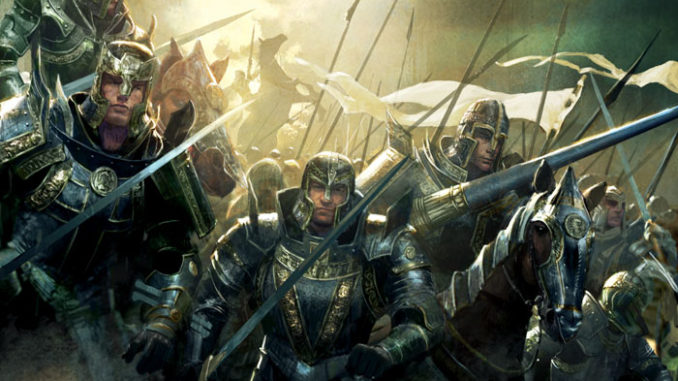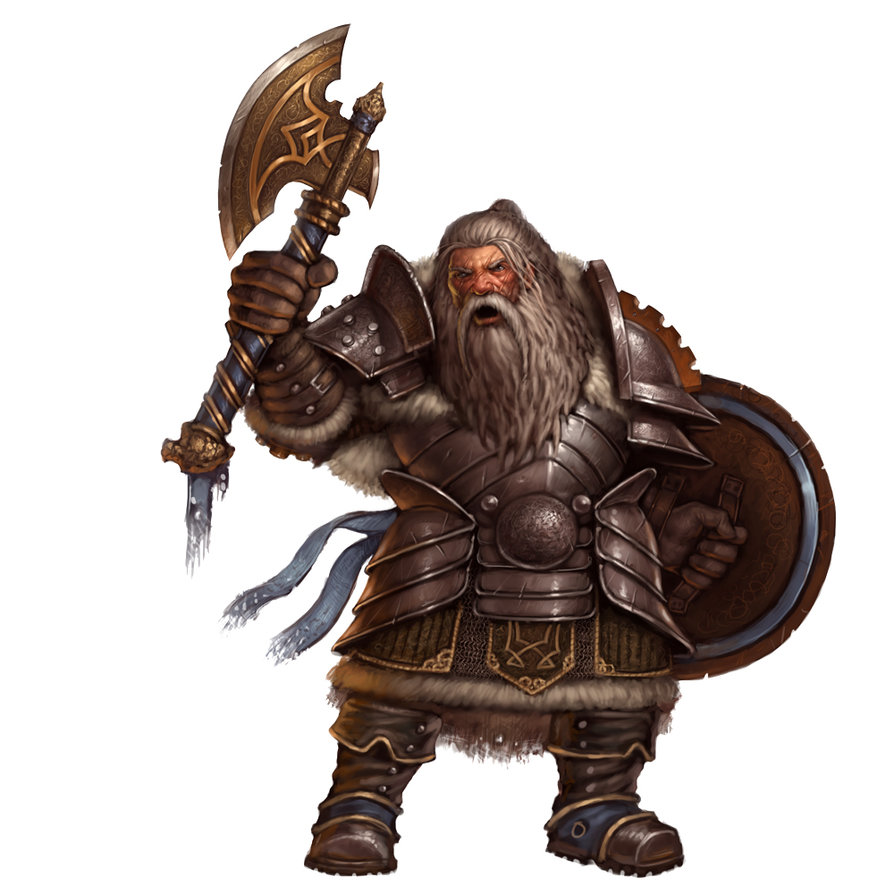
A few weeks ago I did a piece about how mechanics aren’t the defining factors of your character in Dungeons and Dragons Fifth Edition. While I followed that up with a couple of character builds, I really felt the idea deserved a little bit more follow up and so I pulled out a few pregens I had created for a one shot and gave them a few extra levels to show how even the most basic of classes (at least on the surface), can be endlessly versatile.
Orric

Mountain Dwarf Fighter 3
Armor Class 19 (chainmail and shield)
Hit Points 31 (3d10+9)
Proficiency Bonus +2
Speed 25 ft
Alignment lawful good
Languages Common, Dwarvish
Ability Scores
Strength 17 (+3)
Dexterity 8 (-1)
Constitution 16 (+3)
Intelligence 10 (+0)
Wisdom 13 (+1)
Charisma 12 (+1)
Attacks
Melee Attack: Battleaxe +5 1d8+3 slashing damage. 1d10+3 slashing damage if used two handed.
Melee or Ranged Attack: Handaxe +5 1d6+3 slashing damage. Light, thrown (range 20/60).
Skills Acrobatics -1, Animal Handling +1, Arcana +0, Athletics +5, Deception +1, History +0, Insight +3, Intimidation +3, Investigation +0, Medicine +0, Nature +0, Perception +3, Performance +1, Persuasion +1, Religion +0, Sleight of Hand -1, Stealth -1, Survival +1
Equipment chainmail, battleaxe, shield, two handaxes, dungeoneer’s pack, insignia of rank, set of goblin finger bone dice, goblin dagger, set of common clothes, belt pouch w. 10 gp.
Racial Features
Darkvision. Accustomed to life underground, you have superior vision in dark and dim conditions. You can see in dim light within 60 feet of you as if it were dim light, and in darkness as if it were dim light. You can’t discern color in darkness, only shades of gray.
Dwarven Resilience. You have advantage on saving throws against poison, and you have resistance against poison damage.
Dwarven Combat Training. You have proficiency with the battleaxe, handaxe, throwing hammer, and Warhammer.
Tool Proficiency. You gain proficiency with the artisan’s tools of your choice: smith’s tools, brewer’s supplies, or mason’s tools.
Stonecutting. Whenever you make an Intelligence (History) check related to the origin of stonework, you are considered proficient in the History skill and add double your proficiency bonus to the check, instead of your normal proficiency bonus.
Dwarven Armor Training. You have proficiency with light and medium armor.
Class Features
Fighting Style (Defense). While you are wearing armor, you gain a +1 bonus to AC.
Second Wind. You have a limited well of stamina that you can draw on to protect yourself from harm. On your turn, you can use a bonus action to regain hit points equal to 1d10 + 3. Once you use this feature, you must finish a short or long rest before you can use it again.
Action Surge. You can push yourself beyond your normal limits for a moment. On your turn, you can take one additional action on top of your regular action and a possible bonus action. Once you use this feature, you must finish a short or long rest before you can use it again.
Student of War. You gain proficiency with one type of artisan’s tools of your choice.
Combat Superiority. You learn maneuvers that are fueled by special dice called superiority dice. You learn three maneuvers of your choice. Many maneuvers enhance an attack in some way. You can use only one maneuver per attack. You learn additional maneuvers as you gain higher levels. Each time you learn new maneuvers, you can also replace one maneuver you know with a different one. You have four superiority dice, which are d8s. A superiority die is expended when you use it. You regain all of your expended superiority dice when you finish a short or long rest. You gain additional superiority dice at higher levels. Some of your maneuvers require your target to make a saving throw to resist the maneuver’s effects. The saving throw DC is 13.
– Commander’s Strike. When you take the attack action on your turn, you can forgo one of your attacks and use a bonus action to direct one of your companions to strike. When you do so, choose a friendly creature who can see or hear you and expend one superiority die. That creature can immediately use its reaction to make one weapon attack, adding the superiority die to the attack’s damage roll.
–Goading Attack. When you hit a creature with a weapon attack, you can expend one superiority die to attempt to goad the target into attacking you. You add the superiority die to the attack’s damage roll, and the target must make a Wisdom saving throw. On a failed save, the target has disadvantage on all attack rolls against targets other than you until the end of your next turn.
–Rally. On your turn, you can use a bonus action and expend one superiority die to bolster the resolved of one of your companions. When you do so, choose a friendly creature who can see or hear you. That creature gains temporary hit points equal to the superiority die roll + your Charisma modifier.
Proficiencies
Armor Proficiencies: All armor, shields
Weapon Proficiencies: Simple weapons, martial weapons
Tool Proficiencies: Dice, vehicles (land), brewer’s tools, smith’s tools
Saving Throws: Strength and Constitution
Skill Proficiencies: Athletics, Insight, Intimidation, Perception
Background: Soldier.
Military Rank. You have a military rank from your career as a soldier. Soldiers loyal to your former military organization still recognize your authority and influence, and they defer to you if they are of a lower rank. You can invoke your rank to exert influence over other soldiers and requisition simple equipment or horses for temporary use. You can also usually gain access to friendly military encampments and fortresses where your rank is recognized.
Personality Traits: I face problems head-on. A simple, direct solution is the best path to success.
Ideals: Responsibility. I do what I must and obey just authority.
Bonds: I fight for those who cannot fight for themselves.
Flaws: I’d rather eat my armor than admit when I’m wrong.
Background: Orric’s family was renowned for its service to the dwarven military, going far and above what was expected of the common dwarf, most serving for life. Several of his forefathers have given their lives for the defense of the kingdom. Orric himself served as a dwarven knight in a particularly grueling campaign against a goblin horde that had encroached on their territory. The battles were many, the fighting was vicious, and the cost was great, but they eventually broke the might of the horde and scattered them. Orric’s unit was assigned to travel to the surface and track down any of the horde that had been flushed out. But when he got to the surface, he began to see how the corruption of evil had gripped the surface world, and he knew that he couldn’t return to the safety of his home without addressing the needs of the greater world. He formally requested a leave of absence from his service to pursue these goals, with the belief that he will be a better soldier for it when he finally returns to his homeland.
Design Notes: Orric is your classic “sword and board” fighter, the very image of the knight in shining armor. In fact, I toyed with the idea of giving him the Cavalier archetype before I decided I could get more mileage about my point by choosing the Battle Master for all three of these builds. Orric is your traditional dwarf, and I imagine his second wind coming from the reserves of willpower he has deep inside of him. His action surge comes from his faith in his friends and companions, and his desire to not let them down, pushing himself beyond his normal limits to prevent that from happening. His maneuver selection is reminiscent of the battlefield commander and warleader – Commander’s Strike lets him use his allies’ strength as his own, Goading Strike allows him to protect his weaker party members by drawing attention and taking the big hits, and Rally letting him give his allies a chance to regroup and recover in the heat of battle.
Next week we’ll take a look at a second wildly different type of fighter. I’ll see you then.
